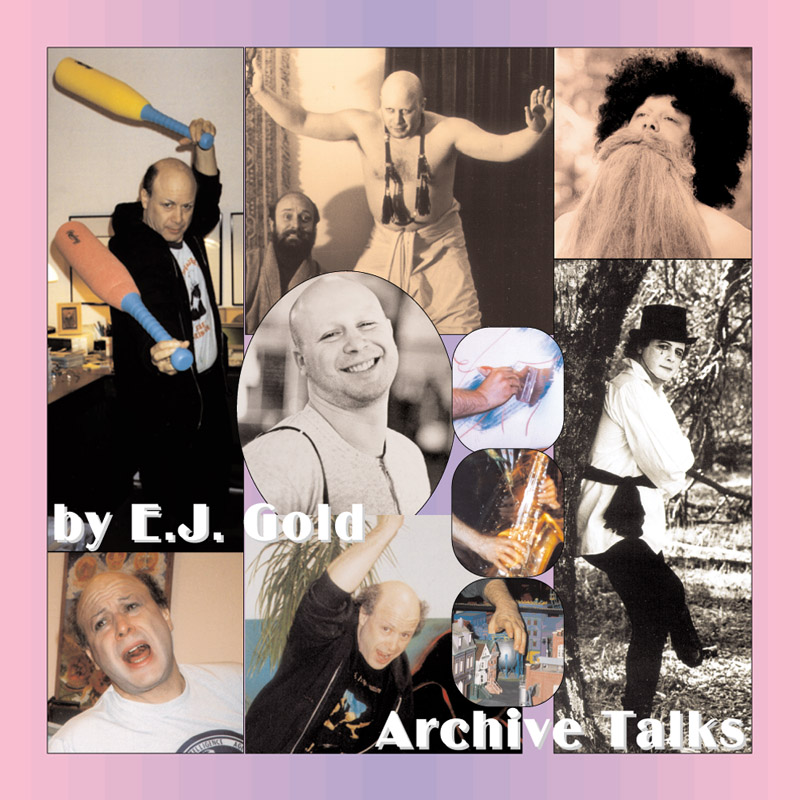

CDT219
Gateways Easter Commentaries
Business
This set presents a running commentary on three music tapes by the composer, E.J. Gold, along with performer/choreographer Menlo Macfarlane, musicologist Nancy Christie and other staff and visitors to the work community. Full unedited recordings made during Easter 1985 celebration at the Institute. Highly recommended as background for anyone giving presentations or marketing Gateways music.
Synopsis
The talk revolves around the intersections of music, composition, improvisation, and shamanistic experience. It traces personal musical influences, particularly from Russian composers like Shostakovich, Tchaikovsky, and Mussorgsky, then explores thematic and structural elements in music through rhythm, tonality, and instrumentation. There are detailed discussions about experimental approaches utilizing jazz, electronic, and world music influences. The conversation expands into symbolic interpretations of musical forms as representations of higher-dimensional spaces, initiation journeys, and abstract ritualistic experiences.
Summary
This discussion offers an in-depth analysis of musical structures, personal artistic influences, and phenomenological aspects of music composition. The speaker recounts childhood experiences with classical composers, particularly Shostakovich, and elaborates on the use of Russian harmonic traditions. Experimental techniques such as juxtaposing classical elements with automated sounds, employing Idée fixe motifs, and using improvisation in live performance are explored.
The role of specific instruments is dissected in terms of both their acoustic properties and metaphorical resonance—such as the oboe’s penetrating timbre, harpsichords for structural balance, and percussion shaping the spatial field of a piece. The layering of musical elements is compared to navigating non-linear temporal and spatial chambers, emphasizing perception-based variations among listeners.
Sections of the talk analyze particular experimental performances, describing spatial microphone techniques, musical randomness in studio improvisation, and chance-driven composition. Several compositions are treated as journeys—whether through shamanistic rites of passage, invoking mythological structures, or exploring trance-like altered states. There is a recurring theme of musical interaction as ritual, evoking initiation experiences through progressive harmonics and polyrhythmic structures. Influences include Schoenberg, Stravinsky, Bartók, and avant-garde composers such as John Cage and Harry Partch.
Dialogue between participants captures experiential reactions to compositions, interpreting them as sonic landscapes where tonal shifts evoke psychological and mythic transformations. Performances at midways and public events are described, noting the emotional and even physiological impacts on listeners. Through comparisons to ritual dance, musical cubism, and the "denial of form," the talk frames music not only as an art form but as an experiential domain capable of reconfiguring perception and consciousness.
Ultimately, the discussion underscores the relationship between controlled form and random intervention in music-making, where silence, rhythmic instability, and harmonic clashes generate expanded aesthetic and mystical states.
Keywords & Key Phrases
- Shostakovich influence
- Idée fixe motifs
- Temporal passage
- Auto-classical sound
- Percussion as spatial structuring
- Oblique tonal shifts
- Sonic invocation
- Improvised harmonic layering
- Shamanistic rhythm
- Ghost dance motif
- Non-linear harmonic progression
- Synchronicity in sound
- Polyrhythmic displacement
- Layered improvisation
- Choreographic sound movement
- Expanded tonality
- Harmonic clash technique
- Sacred harmonic invocation
- Ritual soundscapes
- Cubism in music
- Denial of form
- Shape-shifting structures
- White noise punctuations
- Sonic displacement
- Experimental microphone staging
Graphic Prompt
A surrealist album cover depicting a spectral shaman mid-dance, suspended in cascading waves of sound that ripple through space in concentric geometric distortions. His shadow elongates into a lattice of vibrating musical notes, forming an abstract musical staff that vanishes into infinity. The background fades between deep indigo and neon spectral hues, evoking phantom synesthetic rhythms. The image is textured with faint echoes of oboe reeds, harpsichord keys suspended in air, and a fragmented dulcimer collapsing into mist. The entire scene is a blend of Russian avant-garde aesthetics and dreamlike primitive futurism, capturing a spectral initiation into the unknown.



